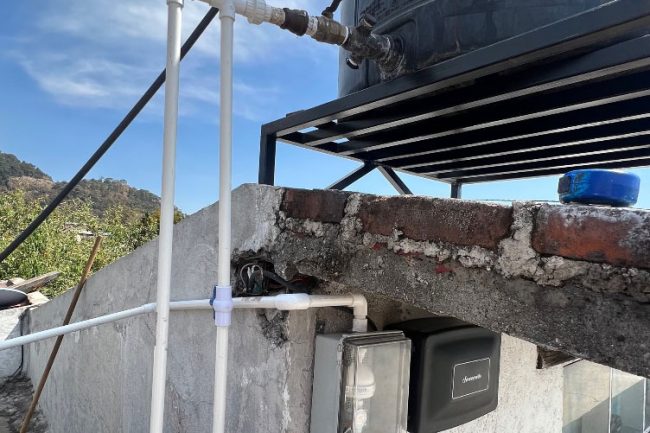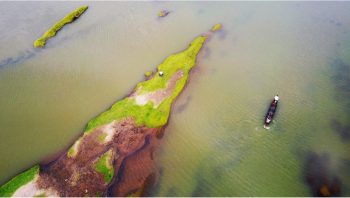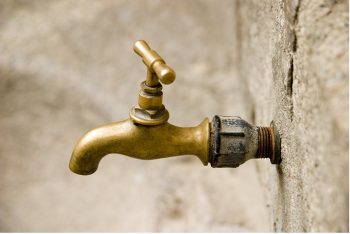Research from a U of T Engineering team could help support household access to safe drinking water in low and middle-income communities by adopting solar-powered ultraviolet (UV) LED illumination to treat water in Mexico’s rainwater harvesting systems.
The team includes Mistelle Haughton (CivMin MASc candidate), Karlye Wong (CivMin PhD candidate) and Professor Ron Hofmann (CivMin). Together, they are among a handful of researchers focusing on the benefits of UV LEDs for water harvesting systems.
The team is currently conducting an extensive systematic review of the literature to map out all the lessons learned in previous case studies where UV is used for the disinfection of rainwater.
“We’ve only found about 30 papers that come close to what we’re implementing, and out of those papers, not many focus on LEDs,” Haughton says.
UV light with wavelengths between 140 and 280 nanometers can inactivate pathogens — this set of wavelengths is known as the germicidal range. The amount of time that light shines on a surface is called the dose. Commercially available UV units typically provide the recommended 40 millijoules per square centimetre dose of UV light to be effective against bacteria, protozoa and most viruses.
“The microbes will absorb the UV light, and as the DNA and RNA absorb the UV, the DNA and RNA become damaged, effectively inactivating the organism, which means that they can’t reproduce and can no longer spread diseases,” Haughton says.
Typically, UV systems used for water treatment rely on mercury lamps that need to be replaced on average once per year. By contrast, UV LEDs can provide a smaller footprint, are easier to maintain and feature remote start or stop with the integration of flow sensors, which can potentially lead to longer lifespans.
“We’re some of the first people to be implementing LED systems in the field,” says Haughton, a member of the Drinking Water Research Group within U of T Engineering’s Department of Civil & Mineral Engineering.
Haughton is building a solar-powered UV disinfection pilot system that can be implemented with UV devices in the field. The waterproof system, which looks like a small black box, can be attached to a UV device and solar panels. The device then runs electricity towards the supply of UV LEDs.
The system can help supplement electrical requirements of the UV systems, which need a reliable energy supply to ensure it is properly operating. The system could also be a safe alternative to chemicals like chlorine, which are often improperly disposed and not preferred in peri-urban communities – the area that transitions between rural and urban communities.
The team’s field work takes place in San Juan Tlacotenco, Morelos, located about an hour outside of Mexico City. Haughton says that currently, households alternate seasonally between chlorinated municipal water and harvested rainwater. Residents also rely on bottled water for drinking, which cost households between $60 to $100 per month.
“When someone has to chemically dose their water supply, they often do it intermittently and there are a lot of aversions to the use of chlorine,” Haughton says.
Rainwater harvesting systems are typically seen in rural or peri-urban areas. Harvesting systems often have a first-flush device, a contraption used to reduce the contaminants in rainwater harvesting systems from the first rainfall.
Right now, the team has implemented one unit in the field and hope to increase that number to 10 in the upcoming months. They are also conducting water quality testing for E. coli and total coliform testing, a basic test for bacterial contamination of water, to monitor for the efficiency of the units.
Historically, the literature has primarily focused on the detection of bacteria and some protozoa in rainwater. The team is exploring the use of molecular testing methods to detect pathogens in the water.
“While we know UVs are very good at inactivating bacterial pathogens, we need to ensure there are no pathogens in the rainwater systems that UV is not good at killing,” Haughton says.
“Higher life form organisms, like worms, require a lot higher dose of UV light and intensity to inactivate these organisms.”
To ensure that implementation is successful, the team is adapting an interdisciplinary approach to not only focus on the technical integration of the units but also on education and user perception.
This research is sponsored by the Urban Challenge Grant 2.0 from the School of Cities, an Institutional Strategic Initiative at U of T. The team has also been supported by alumnus Paul Cadario (CivE 7T3, Hon LLD 1T3), a Distinguished Fellow in Global Innovation at U of T’s Centre for Global Engineering (CGEN), and are consulting with Dr. Yu Chen (ChemE, CGEN), a postdoctoral research associate with CGEN’s Sustainable Peri-Urbanization Initiative (SPUr), on social matters pertaining to the project.
Funding support was also provided by the Natural Sciences and Engineering Research Council of Canada (NSERC), Brown and Caldwell and American Water Works Association (AWWA).
The team’s partners in Mexico include Isla Urbana and Cantaro Azul, which are both organizations that are focused on clean water access in Mexico. The team is collaborating with them to improve treatment of their rainwater harvesting system.
Over the next two years the research team will monitor the UV units in the field. In the short term, they will test the pilot system and develop the preliminary test plan with hopes that this research can continue to evolve.
“I hope this technology can help increase access to clean drinking water for the people who need it the most,” Haughton says.



